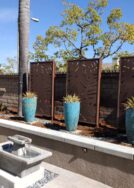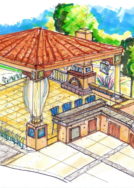Essentially, design is about you, your family, and all the people and pets that will be using the space. Good design provides comfort, familiarity, warmth, and happiness for the enjoyment of your friends and family. Your design plan should be unique and tailored to your lifestyle and taste. Most of all, it should say something about you and your family. Designing the landscape for your own home is fun but it has its pitfalls. Recognizing a good design is a lot easier than creating it and learning it can be difficult to grasp because it’s hard to know where to start.
One thing you should not do is search the internet to discover the principles of landscape design. That won’t help you much at all; that’s for architects and design professionals to learn at college, and it will only put you to sleep. Searching through endless online pics to find your style is exhausting and you may end up with someone else’s bad idea, or a cheap replica. So that your design is not a series of disjointed ideas, it should begin with an overall concept or theme. A concept can be an idea inspired by something like a tropical theme Tiki bar, or forms like circles and squares, or even your favorite color combination. Whatever concept you dream up, stick with it throughout the process; it provides a path for you to follow, ensuring your design plan is cohesive where elements, color, and form interact with one another to enhance their overall value, maximizing the impact of your concept.
Pitfall #1; confusing designing with solely adding decorative elements that often end up masking the same annoying problems.
Be analytical and orderly about the design process. List necessities before your desires. Safety, storage, and privacy are often primary considerations; closely followed by creature comforts such as: swimming pool and spa, barbecue, play area, patio, vegetable garden etc. Consider repairs, upgrades, and any cleanup to be done; these items will need to be completed first. List everything including whimsical features such as your favorite garden animal, or eclectic garden art. These accents are a personal touch that reveals more about your personality and the soul of the overall with design.
Pitfall #2; forgetting to list important items first like storage, safety, and repairs.
A good landscape design solves problems. It resolves issues that require a solution while creating a comfortable living environment. Creating your own design requires deliberation, refinement, and a willingness to trash can a poor design solution and start all over again. Refining a design, is, in many ways, a metamorphosis that turns a “not too attractive worm” into a spectacular butterfly. Be prepared, it will take more than a few attempts to come up with a decent design plan, (the butterfly). Most of all remember, it’s only paper and a series of lines. It’s okay to start over, so keep pushing the boundaries until you’re satisfied.
Pitfall #3; falling in love with a bad design just because you came up with it. Don’t be afraid to trash a bad design and start over.
A great design improves the quality of your home life and makes your investment look like you spent so much more. If you can achieve that, it means you have also increased your property value, a key goal when making property improvements; that is why it’s important to take your landscape design improvements seriously. A poorly designed property will only devalue your home. Some solutions require more complex design work, like a top to bottom remodel, and it’s easy to get overwhelmed, over budget, and in over your head. If you decide to get a professional landscape plan, the fee alone will pay for itself quickly, especially during a major improvement where one simple mistake can easily cost you thousands of dollars and valuable time. Pitfall #4; Not realizing when the plans is not coming together, and it’s time to call a design professional.




